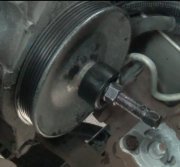When I go into a curve the car will lurch and the steering wheel will attain a position that is a few degrees off of what was the straight ahead position. This position will remain until I enter an opposite curve or if I hit a rough spot on the road. This is very consistent. If I were not aware of this change in geometry, the lurch might literally throw me into another lane. I have checked or replaced the hub bearings. I replaced one inner tie rod end. I replaced the struts. I also noted that the camber angle changes between the two settings when I checked it with a spirit level. Also when I enter a curved-to-the-right exit ramp, I sometime get a slight squealing of the front tire. As long as I am on a straight level road, I have no problem and the steering wheel is positioned as it should be. I tried to check for movement of the steering rack, but I was unable to see any movement or signs of movement.
Some immediate thoughts about the symptoms are:
How can I check the lower ball joints?
How can I check the top strut supports under the plastic caps in the inner fender where the strut nut is located?
SPONSORED LINKS
Monday, November 15th, 2010 AT 5:05 AM



